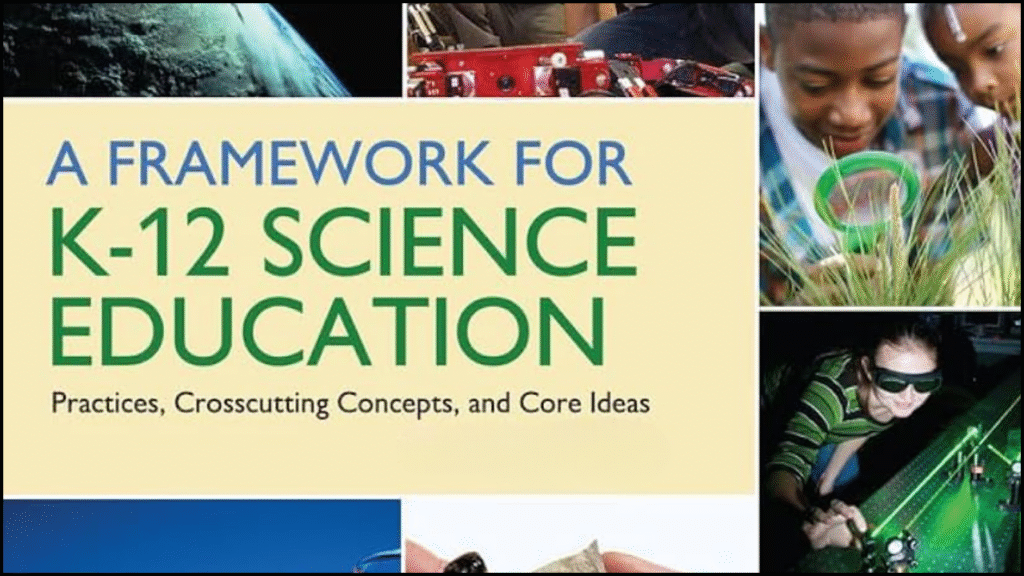
Education in science shapes how students understand the world, solve problems, and prepare for future careers. A framework for K-12 science education provides structured guidance that connects teaching practices, broad concepts, and key disciplinary ideas. The document “A Framework for K-12 Science Education: Practices, Crosscutting Concepts, and Core Ideas” serves as the foundation for the development of the Next Generation Science Standards (NGSS). It highlights not only what students should know but also how they should engage with scientific inquiry and reasoning. A clear focus is placed on building long-term understanding, linking knowledge across subjects, and preparing learners for real-world problem-solving.
Table of Contents
Overview
| Component | Explanation |
|---|---|
| Scientific and Engineering Practices | Focus on the methods and skills students need to investigate questions, design solutions, and evaluate evidence. |
| Crosscutting Concepts | Highlight broad themes that link different disciplines, such as cause and effect or systems thinking. |
| Disciplinary Core Ideas (DCIs) | Represent the essential knowledge in physical sciences, life sciences, earth/space sciences, and engineering/technology. |
| Goal of Framework | Develop scientifically literate citizens capable of critical thinking and informed decision-making. |
Scientific and Engineering Practices
Scientific and engineering practices highlight the actions that students must take to engage actively in science. Rather than memorizing facts, learners apply knowledge in problem-solving contexts.
- Asking questions and defining problems
- Students learn how to pose testable questions and identify engineering challenges.
- Encourages curiosity and sets the foundation for investigations.
- Developing and using models
- Models help represent systems, processes, and phenomena.
- Students practice using diagrams, physical replicas, or simulations.
- Planning and carrying out investigations
- Inquiry skills are strengthened through data collection and experimental design.
- Students refine methods, recognize variables, and ensure reproducibility.
- Analyzing and interpreting data
- Students use graphs, charts, and statistical tools.
- Data-driven reasoning becomes central to conclusions.
- Using mathematics and computational thinking
- Learners apply equations, algorithms, and simulations.
- Strengthens quantitative reasoning in scientific contexts.
- Constructing explanations and designing solutions
- Students propose scientific explanations for observed phenomena.
- In engineering, they design prototypes or processes to meet specific needs.
- Engaging in an argument from evidence
- Evidence-based reasoning teaches critical evaluation.
- Students develop arguments supported by data rather than opinion.
- Obtaining, evaluating, and communicating information
- Communication skills ensure scientific knowledge is shared clearly.
- Students use oral, written, and digital formats effectively.
Crosscutting Concepts
Crosscutting concepts represent ideas that unify all branches of science. They act as bridges across different subjects, allowing students to apply familiar ideas in new contexts.
- Patterns
- Recognition of recurring structures or trends in data.
- Example: spotting similarities in DNA sequences or weather patterns.
- Cause and effect
- Understanding relationships between actions and outcomes.
- Example: analyzing the effect of carbon emissions on climate change.
- Scale, proportion, and quantity
- Examines the size, duration, or amount of scientific phenomena.
- Example: comparing atomic structures to galaxy clusters.
- Systems and system models
- Science emphasizes how parts interact in a system.
- Example: food chains, ecosystems, or mechanical engines.
- Energy and matter
- Follows the flow and conservation of resources.
- Example: tracing energy through photosynthesis and respiration.
- Structure and function
- Links form with purpose in both natural and engineered objects.
- Example: bird wings adapted for flight.
- Stability and change
- Identifies when systems remain constant or evolve.
- Example: river ecosystems adapting to seasonal changes.
Disciplinary Core Ideas (DCIs)
Disciplinary Core Ideas (DCIs) represent the essential building blocks of science education. They are designed to be teachable over multiple grades and emphasize depth over breadth.
Physical Sciences
- Matter and its interactions – Study of atomic structure, chemical reactions, and states of matter.
- Motion and stability – Focus on forces, Newton’s laws, and mechanics.
- Energy – Exploration of sources, transformations, and conservation laws.
- Waves and applications – Study of sound, light, and communication technologies.
Life Sciences
- Molecules to organisms – Structure, function, and processes in living organisms.
- Ecosystems – Dynamics, interactions, energy flow, and cycles.
- Heredity – Mechanisms of inheritance and variation.
- Biological evolution – Evidence and theory of evolution.
Earth and Space Sciences
- Earth’s place in the universe – Study of stars, planets, and cosmic patterns.
- Earth systems – Weather, water cycles, and geologic processes.
- Earth and human activity – Environmental impacts and sustainability.
Engineering, Technology, and Applications of Science
- Engineering design – Problem-solving with creativity and optimization.
- Links among science, engineering, and technology – Application of knowledge to innovation.
- Influence of engineering on society – Examining ethics, responsibility, and benefits of new technology.
Integrated Nature of Framework
The framework emphasizes integration rather than isolation. Students do not learn facts in separate boxes but engage in overlapping practices, concepts, and core ideas.
- Connection between practices and core ideas
- Students apply scientific practices while exploring core disciplinary concepts.
- Application of crosscutting concepts
- Universal themes make learning more cohesive across biology, physics, chemistry, and earth sciences.
- Progression across grade levels
- Each grade builds on prior knowledge, ensuring continuity and increasing complexity.
Importance for Educators and Learners
- For Educators
- Provides structured guidelines to design curriculum and assessments.
- Encourages interdisciplinary teaching and inquiry-based learning.
- For Learners
- Develops critical thinking and scientific literacy.
- Prepares students for higher education and STEM careers.
- Strengthens the ability to make informed decisions in civic and personal life.
Challenges in Implementation
Despite its strengths, the framework requires careful implementation.
- Curriculum alignment
- Schools must adjust existing lesson plans to fit the framework.
- Teacher training
- Educators need support and professional development.
- Assessment design
- Standardized tests must measure not only knowledge but also practices and reasoning.
- Equity and access
- Resources must reach all students, including underrepresented groups.
Comparison: Traditional vs Framework-based Science Education
| Aspect | Traditional Science Education | Framework-based Science Education |
|---|---|---|
| Focus | Memorization of facts | Application of practices and concepts |
| Learning Style | Passive listening | Active investigation and modeling |
| Assessment | Recall-based exams | Evidence-based reasoning and problem-solving |
| Integration | Subjects taught separately | Interdisciplinary and connected learning |
| Outcome | Short-term knowledge | Long-term scientific literacy and skills |
Other Important Information
- Role of Technology
- Digital simulations and computational tools make abstract concepts accessible.
- Online resources provide students with real-time data and collaborative platforms.
- Relevance to Society
- The framework prepares students to analyze climate change, health issues, and technological impacts.
- Encourages ethical and responsible decision-making in science-related policies.
- Global Perspective
- Similar frameworks are being adopted internationally.
- Collaboration in research and education strengthens global problem-solving.
Future Implications
The science education framework provides a roadmap that blends practices, crosscutting concepts, and core ideas into a cohesive structure. Students gain more than textbook knowledge; they learn how to question, investigate, and apply reasoning to real-world challenges. The vision is not only to create future scientists and engineers but also to cultivate citizens who understand the role of science in everyday life. By focusing on integration, inquiry, and long-term learning, the framework transforms K-12 education into a system that prepares learners for both academic and societal success.





